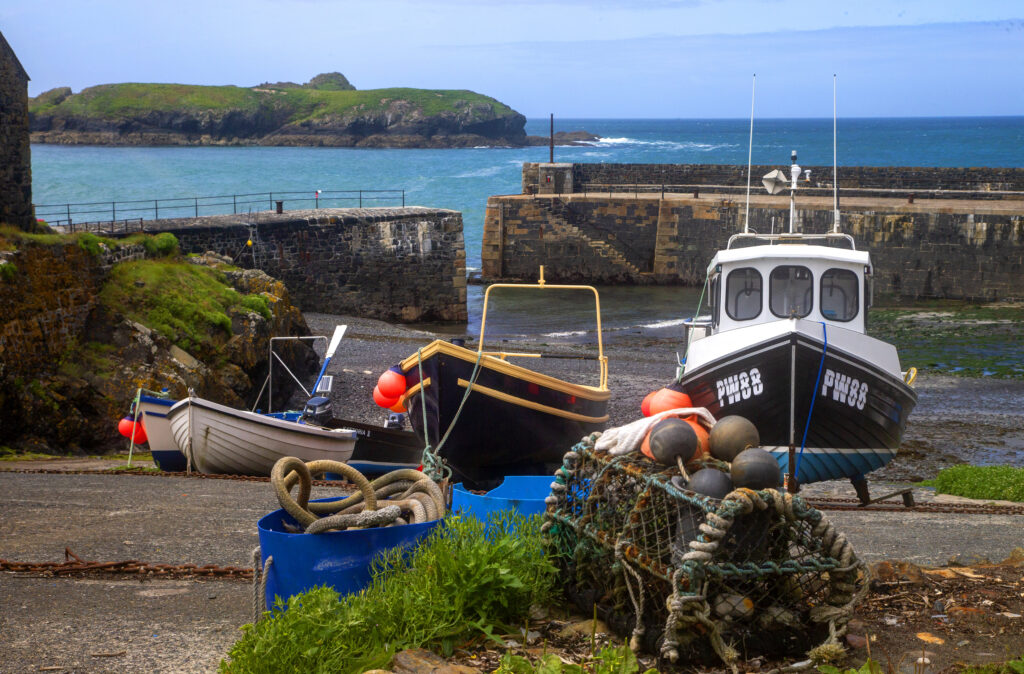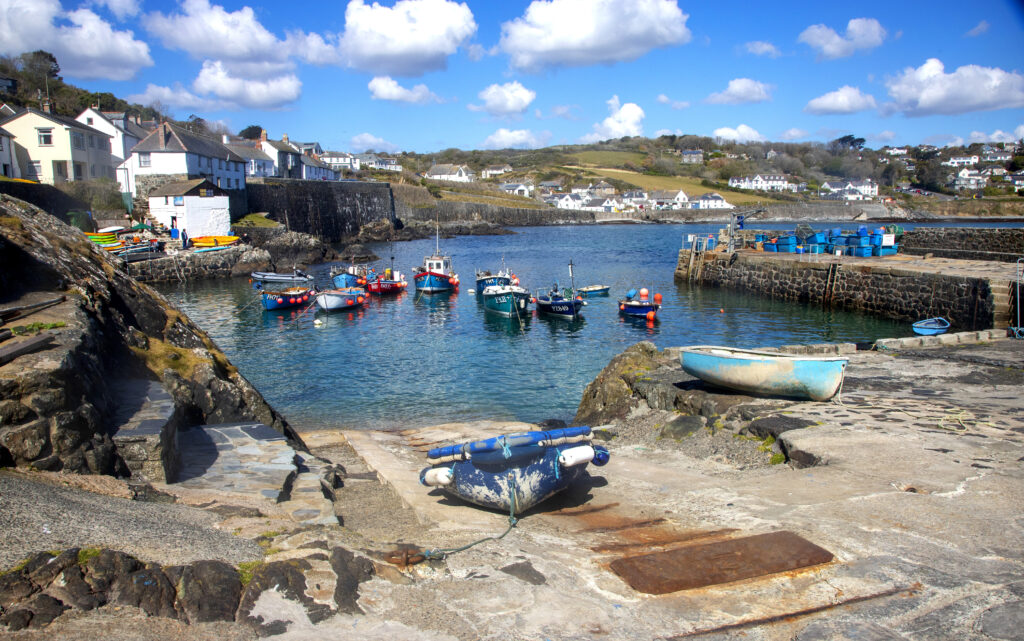Late October 1823. West Cornwall was experiencing summer-like weather with warm sunshine and still seas. In Mount’s Bay, and else-where along the coast, fishermen were obtaining large catches of pilchards which usually visited the shallower waters of the Cornish coast from August to late November.
Thirty-five seines were active in Mount’s Bay, and from eighty to ninety at St. Ives. The St. Michael’s Mount seine had enclosed such a vast shoal that its net had burst, losing a thousand hogsheads, or barrels, of fish. It was said that such immense shoals had never before been seen on this coast at any one period. Large numbers of gannets plunged, arrow-like into the sea to share in the bounty.
On shore, horses and carts plyed constantly from Penzance to St. Ives carrying salt, to preserve the huge catches being made there.
From 1816 until 1823 pilchards had failed to appear off the Cornish coast, causing great poverty among the fishing communities, and distress among the poor who depended on this annual harvest for food in winter. Now, with the seas once again changed to a purple hue by great shoals, all was excitement and happiness. Yet amidst all the euphoria there were elderly folk who said that when the fish approached so near the shore, it was a sure sign of bad weather.
On the evening of Thursday the 30th of October, nineteen fishing boats, containing sixty men, put to sea from Porthleven. The great seine nets had already been cast to enclose large shoals which approached, when, without warning, the gale suddenly arose from the north-east – a gale to be remembered as the worst since 1783! Keeping together, the nineteen small fishing boats miraculously weathered the hurricane force winds throughout the night – at dawn they scattered in all directions, the crews praying to God for their safety.

Some vessels were eventually wrecked on the coast at Mullion and Gunwalloe where farmers, and others, rescued the benumbed fishermen, taking them to their homes for shelter and food. Powerful oxen lumbered to the shore to drag the boats and net to safety. Two boats were brought into Mousehole, and another, with its crew, was picked up by a large vessel and taken to Plymouth.
The majority of the crews were Methodists, and on the Tuesday they all gathered in the Porthleven Meeting House to thank God for their safe deliverance, as they had vowed to do if they survived the hurricane. However, one vessel, with its crew of three, remained unaccounted for. It was not until a fortnight later that a letter arrived at Porthleven, from Rotterdam, telling how the crew had safely been landed there after being picked up by a Dutch brigantine when in great distress off the French coast. In Holland they were cared for by the British Consul, who arranged passage to England. On the 3rd of December the people of Porthleven were both surprised, and delighted, to see the three weary fishermen trudge down the hill to the village, after walking all the way from London!
Later, a committee was formed to organise a distress fund to cover the loss of 102 pieces of double nets, 33 pieces of the same size, quite new, and others, severely damaged – estimated value at £700 – £800.
In Mount’s Bay, those fishermen on the more sheltered western side reached safety, but many other small fishing vessels were wrecked, and their nets lost. At Street-an-Nowan, Newlyn, Gwauas Quay was beaten down by the violence of the waves and an adjoining house completely collapsed. Several boats were damaged and a large pilot-boat broke up on the rocks. The Mariner of Charlestown was reported missing, and sections of two galliots were found floating in Mount’s Bay.

Inland, the hurricane rooted up trees and blew corn and hay ricks into adjoining fields.
Coastguards later walked the coast from St. Ives to the Land’s End in search of further wrecks and possible survivors. The sloop Susanna, sailing from Newport to Alderney, struck the Runnel Stone on November 1st and body of a boy was picked up and buried in the churchyard at Zennor.
At St. Ives the “armada” of fishing boats had already shot four seine-nets, enclosing a mass of pilchards, when the hurricane suddenly arose. The nets were washed away, and the vessels all headed for the harbour, then protected by only a small pier. There, the force of the waves made many capsize and sink, whilst others collided violently into each other, not one seine-boat escaping damage, and valuable seine nets were lost or ruined.
The following day, the beaches and rocks of St. Ives were strewn with wrecks, not only of the smaller fishing boats but of larger going vessels. A Norwegian barquentine, Palm Tree, was driven from the pier but her crew and part of the cargo were saved. The Alfred, of Bideford, was wrecked on the rocks, losing her cargo and one of her crew. The Betsey, of Plymouth went aground losing two men, but she was eventually refloated. A sloop, from North Wales, was completely destroyed but, fortunately, the crew was saved. the same fate befell the schooner Fame, of Padstow, and the Samuel, of Yarmouth, which, although both were completely wrecked, the crews were saved. Much of the saving of life was attributed to the efforts and organisation of Mr. William Bennetts, the Chief Officer of the Coastguard at St. Ives, who with the assistance of others, and using “Captain Manby’s Apparatus”, probably a form of breeches-buoy, worked throughout the terrible hurricane.

The stern of the Elenoar and Grace, of Plymouth, was washed ashore at Hayle on the Sunday, and other vessels “of which no particulars will ever be known”, were also lost, as capstans, dollars, and wreckage were washed up along the coast. It was estimated that the damage to the fishing vessels and nets at St. Ives amounted to a colossal £2,000.
On the day of the hurricane, five vessels had sailed from the harbour at Portreath,’ laden with copper-ore, and four from Hayle, all bound for Swansea with its smelting facilities. Fears were expressed for their safety when the body of the wife of a Captain Hancock, of Swansea, a passenger on board the Providence, was washed on shore between St. Ives and Portreath. The fears were justified when the vessel was found, wrecked, on the rocks “under Zennor Churchtown”.
Pieces of the Retford, of Padstow, and of the Richard of Swansea, were also washed on shore at Cape Cornwall and Sennen Cove. The stem of the John Adams, of Hayle, another of the ill-fated copper-fleet, was washed up at Holywell Bay, Cubert. It was probably three bodies of her crew which were found at the foot of the cliffs beneath Wheal Charlotte Mine, between Chapel Porth and Porthtowan – all headless, and one with a leg missing. Another Providence, and the Plover, were wrecked at St. Ives, but the John Stroud, and yet another Providence, miraculously survived the hurricane to reach. Swansea safely. The ninth vessel, the Underhill, was driven, helplessly, to Brest where she arrived badly damaged, but eventually sailed into Penzance harbour in mid January, 1824.
For weeks afterwards bodies were washed ashore along the north coast of Cornwall and 180 vessels were recorded as being wrecked on the north-east coast alone!
A report from Scilly described the hurricane as a “white squall”, which whirled up substances such as dry seaweed, straw, etc., to great heights. Roofs of thatch, slates, and tiles, flew in all directions. “Many cottages etc. were completely peeled of their covering in less than a quarter of an hour, the straw in its ascent resembling a thick cloud of smoke.” The shivering inmates remained awake all the Thursday night, soaked by rain, and the hurricane continued to rage throughout the Friday, and only a little less on the Saturday.
“Many vessels were damaged, losing chains, rudders, masts, etc., but as there were none at sea, no lives were lost.”

These accounts, never before published, and pulled from the files of the West Briton and Royal Cornwall Gazette of the period, will illustrate the devastation created by fierce storms in the days of sail, when there was often no alternative but for vessels to ride before them. It also illustrates not only the great activity of the then thriving Cornish fishing industry, but the immense coastal trade before the coming of the railway.
With the use of the powerful marine engines of today, hurricanes and gales no longer present such a hazard as they did in 1823 – but sailing vessels still remain vulnerable, as was illustrated by the affects of high sudden winds during the Fastnet race a few years ago.